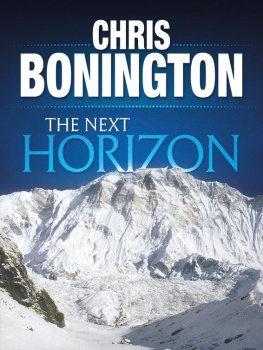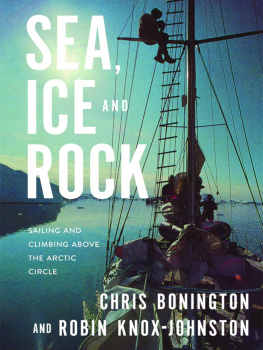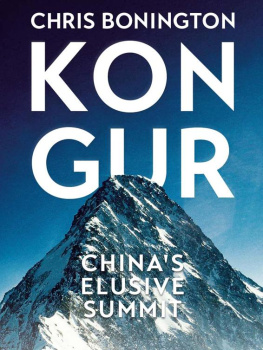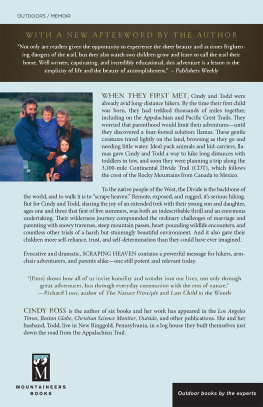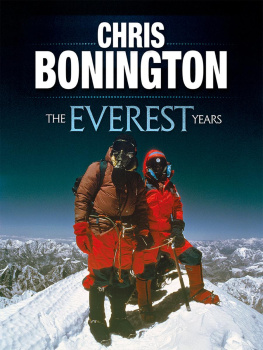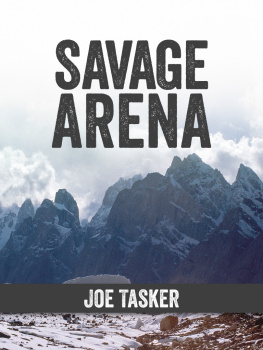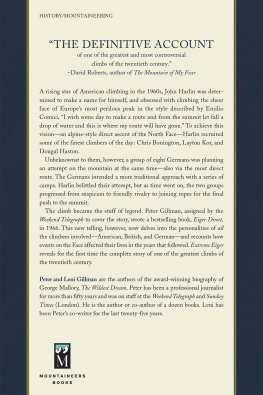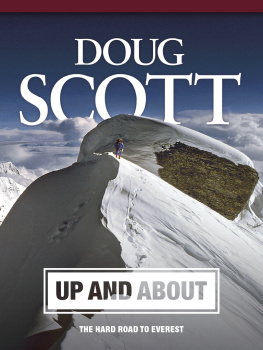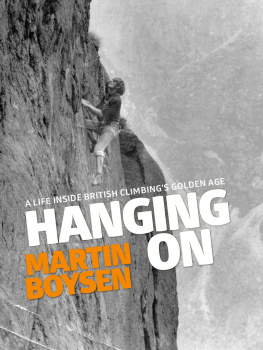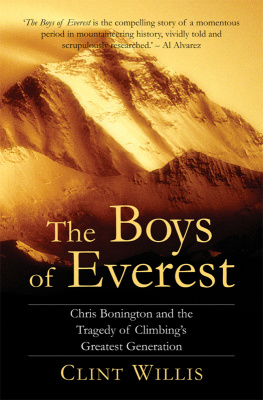The two trucks rattled and bounced over the rough dirt road in a swirl of dust that was instantly whipped away by the blast of the wind. On either side of the road was a forest of dead trees, a graveyard of whitened skeletons with limbs twisted by incessant wind and bleached by sun and weather; a sky filled with a fleet of great sausage-like clouds, brown-grey zeppelins driven in from the Pacific by the constant fury of the Roaring Forties. In the distance, just visible above the petrified forest, were the mountains jagged dark shapes that seemed dwarfed by the high vault of the sky.
It was the 28th November 1962 and we were on the last leg of our journey to climb the Central Tower of Paine. It didnt matter that we were cold and uncomfortable in the back of the lorry, sandwiched between packing cases and the canvas roof, for we were very nearly at the end of our journey, soon to see the mountain we had to climb. This first glimpse of the objective is one of the most exciting moments of any expedition. Up to that point there is always a feeling of unreality about the entire enterprise. It is difficult to believe that one will ever overcome all the mundane problems of raising money, begging equipment; it is even more difficult to imagine the jump from England to mountains in some distant corner of the earth.
We had spent over three weeks travelling from England, firstly by passenger liner to Valparaiso in Chile, then on an exhilarating flight down the spine of the Andes to Punta Arenas, a small windswept town on the Straits of Magellan, and now we were driving north, across the pampas, towards our objective.
The truck pulled up a small hill and round a shoulder; the ground, grass clad, with only the occasional lonely finger of a dead tree, stretched down into a shallow valley, rising gently on the other side to a low ridge. The pampas was like an Atlantic swell, rolling away into the foothills of the Paine Massif, dusty green, and yet the air was so clear that you could pick out each windswept shrub and protruding spine of rock. And there, some twenty miles away, was the Central Tower of Paine a slender blade of rock that at this distance seemed dominated by the squat mass of the mountains round it.
It was this peak that had triggered my resolve to abandon a conventional career and make a living around climbing, but at that instant, as we gazed at the distant nobble of rock which was to be the focus of our lives for the next few weeks, I was filled with a simple excitement at the prospect of tackling it. One of the features of climbing is the intensity of concentration it exacts. In its basic form, if you are poised on a rock wall a hundred feet above the ground, all other thoughts and problems are engulfed by the need for absolute concentration. There is no room for anything other than the problems of staying in contact with the rock and negotiating the next few moves. In this respect, climbing offers an escape, or perhaps it would be better to describe it as a relaxation from everyday worries of human relationships, money or jobs. This relaxation lasts for longer than just those moments when you are actually climbing and life is in jeopardy.
Sitting on a ledge, belaying ones partner, senses are extra acute; the feel of the rock under hand, of the wind and sun, the shape of the hills all these are perceived with an extra intensity. Absorption in immediate surroundings once again excludes ones everyday life. On an expedition the same withdrawal from everyday affairs takes place, but here the expedition becomes a tiny little world of its own with, in microcosm, between its members, all the tensions and conflict that can take place in the larger world. The all-consuming aim is to climb the mountain of ones choice and this transcends in importance anything that might be happening beyond it.
For the next few weeks nothing mattered to me but this distant tower of rock and the small group of people who were concerned in climbing it.
There were nine of us altogether, seven climbers, two wives (one of them my own), and a three-year-old child. Wendy, Elaine and young Martin were not part of the expedition but inevitably filled part of the story. Barrie Page, the leader of the expedition, was a geologist and had visited the Paine Group two years before as a member of a scientific expedition. With him had been two other members of our group, Derek Walker and Vic Bray. They had made a map of the area and carried out a geological survey, but they had been enthralled by the Towers of Paine: three magnificent granite spires, set in the midst of some of the most exciting rock scenery in South America. The smallest, the Northern Tower, had been climbed by an Italian expedition in 1958, but the Central and Southern Towers were unclimbed. The Central Tower was especially attractive, forming a perfect rock spire, sheer on every side. They didnt have the equipment to tackle it but resolved to return. Barrie had invited Don Whillans and myself. I had at first refused because of my new job with Unilever, but had then realised that I could not resist the opportunity. The sixth member of the team was John Streetley, who had had a mercurial climbing career in the mid-fifties while studying at Cambridge, and had then returned to his native Trinidad to build up a successful business. He was going to join us later in the expedition. Ian Clough, with whom I had climbed the North Wall of the Eiger that summer, had joined us at the last minute, giving up a place he had at a teachers training college, and paying his own fare out.
Our little convoy came to a halt at a police check-post it was like a small Customs point, with a hut by the road and a red and white drop-bar barring our way. There were two carabineros in neat grey uniforms with pistols at their sides. They seemed almost to expect us. The chief, lean, tough-looking and very tanned, asked Barrie something in Spanish. He got out some papers; the carabinero looked at them but didnt seem satisfied and started to grill Barrie. The other carabinero, a great slob of a man who reminded me of pictures I had seen of Hermann Goering, just looked bored.
At first the rest of us had taken no notice, thinking that our passage through the checkpoint would be a routine matter, but we could quickly sense Barries growing excitement and the hostility of the carabineros. We gathered round, tensed and anxious.
Whats up, Barrie? asked Don.
Oh, just a bit of bureaucracy, said Barrie, and kept arguing.
Seems to be more than that to me, said Don. Why wont the buggers let us through? Weve got permission to climb the Tower, havent we?
Of course we have, said Barrie.
Well havent you got it with you in writing?
We dont need it. Weve got blanket permission to go into the Paine Massif, said Barrie. Theyre just being awkward.
Well they should bloody well know, shouldnt they? Either you need permission or you dont.
There was something about Barries manner he was a born salesman, effervescent, fast talking and very difficult to pin down that was the very opposite to Don, who likes everything spelt out in black and white. The argument developed into a three-cornered battle between Barrie, Don and the carabineros, with very little communication between any of them. The post was at the Estancia Castillo, a big ranch managed, as many of the estancias are, by an Englishman. He eventually came to our rescue and talked us through the police post, calming our ragged nerves with a very English afternoon tea in his home. Set in the great empty space of the pampas, Mr Saunders house was what I imagine an English country house of forty years ago must have been like, with its array of servants, tea in a silver service and big soft armchairs nestling on a thick pile carpet. Our own appearance, modern-day climbers, must have seemed a little incongruous. We were still agitated by the brush with the police, the possibility that having come so close we could be stopped from reaching the Tower. We had already heard that an Italian climbing expedition was coming out later in the season. Don read Machiavellian plots into what had just happened.

